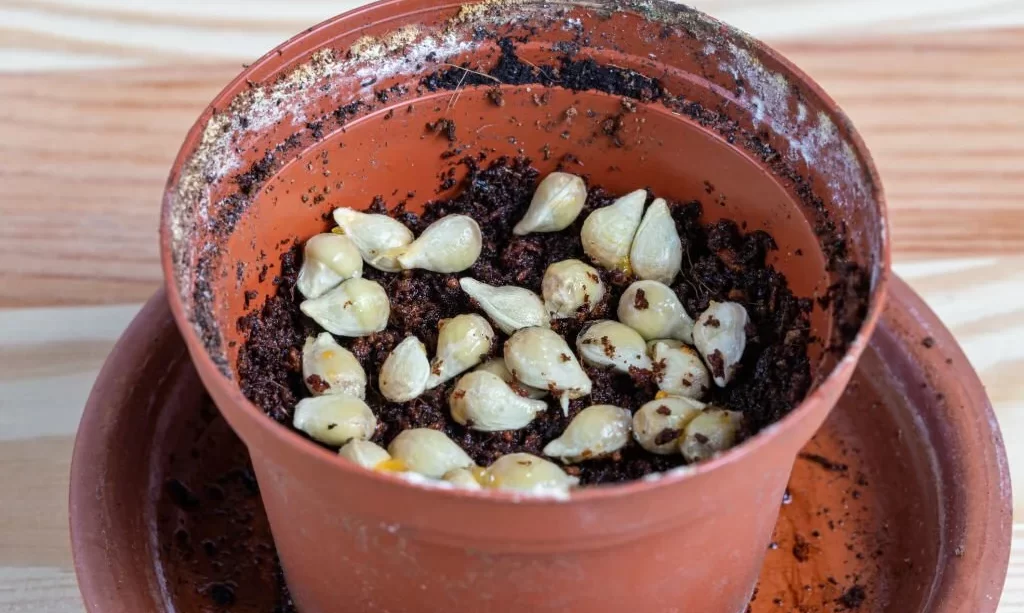The allure of growing your own grapefruit tree, with its luscious and tangy fruits, is a rewarding endeavor for any gardening enthusiast. Cultivating grapefruit from seeds allows you to witness the entire life cycle of this delightful citrus tree, from tiny seeds to a flourishing fruit-bearing marvel. In this guide, we will take you through the step-by-step process of growing grapefruit from seeds, transforming your home or garden into a citrus paradise. Discover the joys of nurturing your own citrus splendor and savoring the fruits of your labor.
Collecting Grapefruit Seeds
The first step in your grapefruit-growing journey is to gather the seeds. Here’s how to do it:
- Select Ripe Grapefruit: Start by selecting ripe and healthy grapefruit. Look for fruits that are vibrant in color, plump, and free from blemishes or signs of decay. The quality of the fruit will impact the quality of the seeds.
- Extracting Seeds: Cut the grapefruit open and gently extract the seeds. You can use a knife or your fingers for this. Be cautious not to damage the seeds while doing so.
- Cleaning Seeds: Once you have the seeds, rinse them thoroughly in clean water. This removes any traces of fruit pulp or juice. Cleaning the seeds helps prevent mold and fungal issues during germination.
Preparing Grapefruit Seeds for Planting
Before planting grapefruit seeds, they need a bit of preparation:
- Drying: Lay the cleaned seeds on a paper towel or a clean cloth to air-dry for a day or two. Ensure they are completely dry before proceeding to planting.
- Seed Selection: While all grapefruit seeds can potentially grow into trees, consider selecting the plumpest and healthiest seeds for planting. Healthy seeds are more likely to germinate successfully.
With your grapefruit seeds collected, cleaned, and ready, you’re now prepared to embark on the exciting journey of growing your very own grapefruit tree.
Planting Grapefruit Seeds
Planting grapefruit seeds is the next step in your journey to grow a citrus tree from scratch. Here’s how to go about it:
- Container Selection: Choose a suitable container or pot for planting the grapefruit seeds. Ensure the container has drainage holes to prevent waterlogged soil. Using a pot with a lid or plastic wrap can create a greenhouse effect, aiding germination.
- Planting Depth: Plant the grapefruit seeds about half an inch (1.3 cm) deep in the potting mix. You can plant multiple seeds in the same container, but keep them spaced apart to allow room for growth.
- Potting Mix: Use a well-draining potting mix that is specifically designed for citrus trees or create your own mix. Ensure it is lightweight and airy to promote healthy root development.
- Watering: After planting, water the potting mix thoroughly. Ensure the soil is consistently moist but not waterlogged. Using a spray bottle to mist the soil’s surface can help maintain moisture levels.
- ALL-NATURAL MIX: Burpee Organic Premium Potting Mix is formulated with plant food & coconut coir to promote seed & root growth and healthy flower, vegetable & herb plants. OMRI Listed for organic use. This premium mix releases essential nutrients immediately.
- PERFECT FOR CONTAINERS: Use this growing mix for planting in containers or raised beds. The potting soil feeds plants instantly, then provides a slow release plant food that feeds for up to 3 months. Whether you’re growing organic herbs, vegetable seeds or flowers in raised beds or patio containers, this growing mix will make the job a breeze.
- RETAINS MOISTURE: Sustainable coconut coir helps hold the perfect amount of water for potted plants, indoor or outdoors. Coconut coir is an organic and sustainable resource that helps maintain moisture between waterings for vibrant flowers and delicious vegetables and herbs.
- TIP FOR FLOWER POTS: Use flowers and foliage of varying heights to add dimension to your container. Place tall plants in the middle or back, mounding plants all around and spilling plants at the edge. Your live flowers will thrive with this premium potting mix.
- 100% GUARANTEED: Burpee is committed to the success of all gardeners. We treat each order with care to ensure healthy seeds, plants & gardening supplies are packaged and sent in excellent condition. If you are unsatisfied with your purchase, we aim to make it right!
Germination and Seedling Care
Once the grapefruit seeds are planted, it’s time to nurture them through the germination process:
- Germination Time: Be patient, as grapefruit seeds can take several weeks to a few months to germinate. It’s not uncommon for citrus seeds to have varying germination times.
- Temperature and Humidity: Maintain a warm and consistent temperature between 70-75°F (21-24°C) to encourage germination. Using a lid or plastic wrap over the container helps retain humidity, creating a conducive environment for sprouting.
- Indirect Light: Place the container in a location with indirect sunlight or under fluorescent lights. Avoid placing it in harsh, direct sunlight during this delicate stage.
Transplanting Grapefruit Seedlings
Once your grapefruit seeds have germinated and seedlings have developed, it’s time to think about transplanting them to a more spacious and permanent location:
- Timing: Transplant the seedlings when they are around 6 inches (15 cm) tall. This is typically several months after germination.
- Prepare the New Location: Choose a sunny spot in your garden or a larger container for transplanting. The location should receive ample sunlight and have well-draining soil.
- Gentle Transplanting: Carefully lift the seedlings from the container and transfer them to the new location. Handle the delicate roots with care, and ensure the seedlings are planted at the same depth as they were in the container.
- Acclimatization: Gradually acclimate the seedlings to their new outdoor conditions by exposing them to the outdoor environment for a few hours each day, gradually increasing the duration. This helps prevent shock.
By following these steps, you’re well on your way to cultivating your own grapefruit tree. As you continue to care for your growing seedlings and eventually transplant them to a permanent location, you’ll be rewarded with the beauty of a flourishing citrus tree and, in time, the pleasure of harvesting your very own grapefruits.
Citrus Care and Maintenance
Caring for your grapefruit tree is essential to ensure its health and productivity. Here are key aspects of citrus care:
- Watering: Maintain consistent moisture by watering the tree regularly, especially during dry spells. Ensure the soil is well-draining to prevent waterlogging, which can harm the roots.
- Fertilization: Feed your grapefruit tree with a balanced, slow-release citrus fertilizer in the spring and early summer. Citrus trees have specific nutrient requirements, and the right fertilizer will help them thrive.
- Pruning: Prune your tree regularly to maintain its shape and improve air circulation. Pruning is also essential for removing dead or diseased branches.
- Pest and Disease Management: Keep an eye out for common citrus pests such as aphids and scale insects. Monitor the leaves and fruits for signs of diseases like citrus canker or citrus greening. Early intervention is key to managing these issues.
- PROMOTES TREE GROWTH – This tree growth supplement is designed to balance your tree’s critical nutrients including nitrogen, phosphate, magnesium, zinc and others.
- IMPROVES ROOT FORMATION – This fertilizer is designed to encourage vigorous root growth improving the resilience of your trees throughout the year.
- WORKS WITH ALL TREES – This formula is designed to work with all types of trees, both coniferous and deciduous. Its flexible use makes it a great tool for improving the health of all trees on your property.
- GREAT FOR MATURE OR NEWLY PLANTED TREES – This tree growth supplement can be used on young or mature trees. It improves the nutrient balance and health of a tree regardless of its age.
- INSTRUCTIONS – Mixing ratios depend on the diameter of the tree to which the product is being applied to. See the Soil Application rate chart on the product’s packaging to determine the appropriate mixing ratio. Thoroughly soak the soil around the plant’s root zone. Repeat every 4-6 weeks.
Patience and Pruning for Fruit Production
Growing grapefruits from seeds requires patience, especially when it comes to fruit production:
- Fruit Development: It can take several years for a grapefruit tree grown from seeds to start producing fruit. Be patient and continue to provide proper care during this period.
- Pruning for Fruit: Pruning plays a crucial role in fruit production. Regularly prune your tree to improve fruit quality and make harvesting easier. Thin out excess fruit to encourage the growth of larger, juicier grapefruits.
Troubleshooting Common Issues
While grapefruit trees are generally hardy, they may face some common challenges:
- Yellowing Leaves: Yellow leaves can indicate nutrient deficiencies or overwatering. Adjust your care routine accordingly and address nutrient imbalances.
- Scale Insects: Scale insects are a common problem for citrus trees. Use neem oil or insecticidal soap to control these pests.
- Fruit Drop: Excessive fruit drop can result from stress, including drought or fluctuations in temperature. Maintain consistent care and address stress factors.
- Disease Management: Keep a close watch on your tree for signs of diseases like citrus canker or citrus greening. Consult local agricultural authorities or extension services for guidance on managing such issues.
Conclusion
Growing grapefruit from seeds is a fulfilling journey that allows you to witness the transformation of tiny seeds into a thriving citrus tree. While it requires patience, attention, and care, the rewards are bountiful. Your grapefruit tree will not only offer delicious and healthy fruit but also grace your garden with its vibrant presence.
As you continue to care for your grapefruit tree, remember that it’s a living testament to your dedication and horticultural skills. It’s a reminder of the wonders of nature and your role in nurturing life from a humble seed to a magnificent fruit-bearing tree. Enjoy the beauty and bounty of your homegrown grapefruits, and share the joy of gardening with family and friends.







